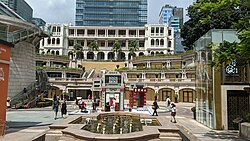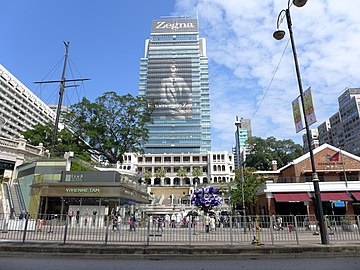
Kowloon Walled City was an extremely densely populated and largely ungoverned enclave of China within the boundaries of Kowloon City, British Hong Kong.
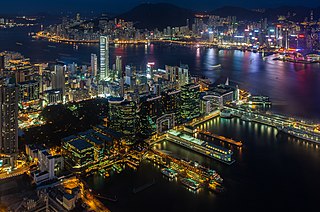
Tsim Sha Tsui, often abbreviated as TST, is an urban area in southern Kowloon, Hong Kong. The area is administratively part of the Yau Tsim Mong District. Tsim Sha Tsui East is a piece of land reclaimed from the Hung Hom Bay now east of Tsim Sha Tsui. The area is bounded north by Austin Road and in the east by Hong Chong Road and Cheong Wan Road.

The Kowloon Walled City Park is a park in Kowloon City, Kowloon, Hong Kong. The Kowloon Walled City had been a military stronghold since the 15th century due to its coastal location and was a slum. Under an agreement between the Government of Hong Kong and the People's Republic of China, the Kowloon Walled City was demolished in the 1990s. Some historic buildings and features were preserved for incorporation into the new park.
Declared monuments of Hong Kong are places, structures or buildings legally declared to receive the highest level of protection. In Hong Kong, declaring a monument requires consulting the Antiquities Advisory Board, the approval of the Chief Executive of Hong Kong as well as the publication of the notice on the Hong Kong Government Gazette.

The former Central Police Station of Hong Kong, located at the eastern end of Hollywood Road, in Central, Hong Kong has been redeveloped into a cultural and shopping destination generally called Tai Kwun (大館). Tai Kwun is composed of three declared monuments: the former Central Police Station, former Central Magistracy and Victoria Prison.
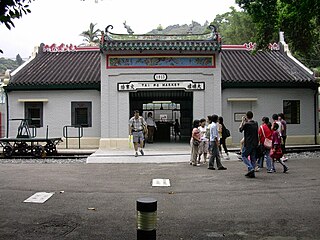
The Hong Kong Railway Museum is a railway museum in Tai Po, Hong Kong. It is now under the management of the Leisure and Cultural Service Department. Opened on 20 December 1985, it is located at the site where the old Tai Po Market railway station was built in 1913. Admission to the museum is free.

Nathan Road is the main thoroughfare in Kowloon, Hong Kong, aligned south–north from Tsim Sha Tsui to Sham Shui Po. It is lined with shops and restaurants and throngs with visitors, and was known in the post–World War II years as the Golden Mile, a name that is now rarely used. It starts on the southern part of Kowloon at its junction with Salisbury Road, a few metres north of Victoria Harbour, and ends at its intersection with Boundary Street in the north. Portions of the Kwun Tong and Tsuen Wan lines run underneath Nathan Road. The total length of Nathan Road is about 3.6 km (2.2 mi).
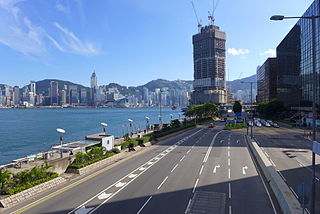
Salisbury Road is a major road in Tsim Sha Tsui, Kowloon, Hong Kong.

Kowloon Park is a large public park in Tsim Sha Tsui, Kowloon, Hong Kong. It has an area of 13.3 hectares and is managed by the Leisure and Cultural Services Department.
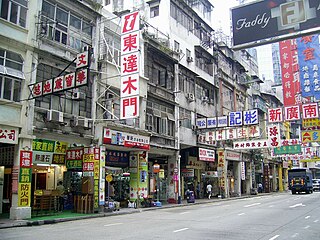
The architecture of Hong Kong features great emphasis on contemporary architecture, especially Modernism, Postmodernism, Functionalism, etc. Due to the lack of available land, few historical buildings remain in the urban areas of Hong Kong. Therefore, Hong Kong has become a centre for modern architecture as older buildings are cleared away to make space for newer, larger buildings. It has more buildings above 35m and more skyscrapers above 150m than any other city. Hong Kong's skyline is often considered to be the best in the world, with the mountains and Victoria Harbour complementing the skyscrapers.

Blackhead Point, also known as Tai Pau Mai indigenously, or by the names Tsim Sha Tsui Point and Signal Hill (訊號山), was a cape before any land reclamation took place in Tsim Sha Tsui, Kowloon, Hong Kong. It currently remains a small hill near the coast.
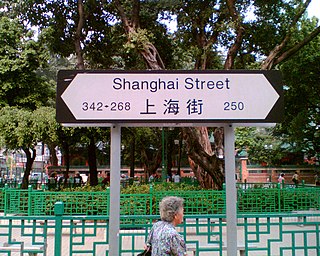
Shanghai Street is a 2.3 km long street in the Jordan, Yau Ma Tei and Mong Kok areas of Kowloon, Hong Kong, China. Completed in 1887 under the name of Station Street (差館街), it was once the most prosperous street in Kowloon. It originates from the south at Austin Road, and terminates in the north at Lai Chi Kok Road. Parallel to Shanghai Street are Nathan Road, Temple Street, Portland Street, Reclamation Street and Canton Road. Though parallel, Shanghai Street was marked by 2- to 3-floor Chinese-style buildings while Nathan Road was marked by Western-style buildings.
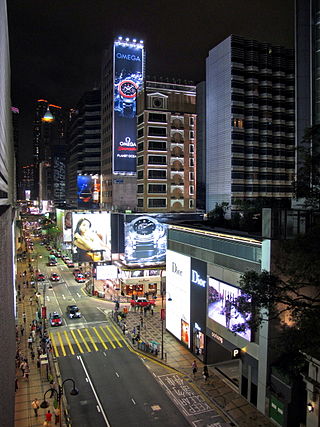
Canton Road is a major road in Hong Kong, linking the former west reclamation shore in Tsim Sha Tsui, Jordan, Yau Ma Tei, Mong Kok and Prince Edward on the Kowloon Peninsula. The road runs mostly parallel and west to Nathan Road. It starts from the junction with Salisbury Road in the south and ends in the north at the junction with Lai Chi Kok Road in the Prince Edward area. The southern section of Canton Road is home to many upscale retail shops, shopping centres and others business establishments, with busy traffic from both vehicles and pedestrians from morning till late at night.

The Antiquities and Monuments Office (AMO) is a Hong Kong government organization established in 1976 under the Antiquities and Monuments Ordinance to protect and preserve historic monuments. Housed in the Former Kowloon British School, the AMO is responsible for identifying, recording and researching buildings and items of historical interest, as well as organising and coordinating surveys and excavations in areas of archaeological significance. The Commissioner for Heritage's Office under the Development Bureau of the Hong Kong government currently manages the Office.

King Yin Lei is an historic mansion in the Mid-Levels area of Hong Kong. It is within the Wan Chai District.

This article details the history and status of heritage conservation in Hong Kong, as well as the role of various stakeholders.

The North Kowloon Magistracy is a historic building and former Magistrate's Court located at No. 292, Tai Po Road, Shek Kip Mei, Kowloon, Hong Kong.
The Revitalising Historic Buildings through Partnership Scheme is an initiative launched by the Hong Kong Government, part of a broader policy of heritage conservation in Hong Kong. In order to preserve and put historic buildings into good use and promote public participation in conserving historic buildings, the Hong Kong Government has chosen Government-owned buildings for adaptive reuse under the Scheme.

The Old Kowloon Fire Station is a former fire station in Tsim Sha Tsui, Kowloon, Hong Kong. Together with the Former Marine Police Headquarters, it is now part of a commercial complex called 1881 Heritage.

Tai Kwun, or the Former Central Police Station Compound includes three declared monuments in Central, Hong Kong: the former Central Police Station, the Former Central Magistracy, and the Victoria Prison. Surrounded by Hollywood Road, Arbuthnot Road, Chancery Lane and Old Bailey Street, the compound underwent a heritage revitalisation and reopened to the public on 29 May 2018 as "Tai Kwun", a centre for heritage and arts.
